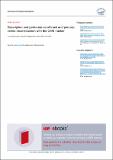Description and performance of track and primary-vertex reconstruction with the CMS tracker
| dc.contributor.author | The CMS Collaboration | |
| dc.date.accessioned | 2021-10-27T19:57:03Z | |
| dc.date.available | 2021-10-27T19:57:03Z | |
| dc.date.issued | 2014-01-01 | |
| dc.identifier.uri | https://hdl.handle.net/1721.1/133865 | |
| dc.description.abstract | © CERN 2014 for the benefit of the CMS collaboration. A description is provided of the software algorithms developed for the CMS tracker both for reconstructing charged-particle trajectories in proton-proton interactions and for using the resulting tracks to estimate the positions of the LHC luminous region and individual primary-interaction vertices. Despite the very hostile environment at the LHC, the performance obtained with these algorithms is found to be excellent. For t events under typical 2011 pileup conditions, the average track-reconstruction efficiency for promptly-produced charged particles with transverse momenta of pT> 0.9GeV is 94% for pseudorapidities of |η| < 0.9 and 85% for 0.9 < |η| < 2.5. The inefficiency is caused mainly by hadrons that undergo nuclear interactions in the tracker material. For isolated muons, the corresponding efficiencies are essentially 100%. For isolated muons of pT= 100GeV emitted at |η| < 1.4, the resolutions are approximately 2.8% in pT, and respectively, 10μm and 30μm in the transverse and longitudinal impact parameters. The position resolution achieved for reconstructed primary vertices that correspond to interesting pp collisions is 10-12μm in each of the three spatial dimensions. The tracking and vertexing software is fast and flexible, and easily adaptable to other functions, such as fast tracking for the trigger, or dedicated tracking for electrons that takes into account bremsstrahlung. | |
| dc.language.iso | en | |
| dc.publisher | IOP Publishing | |
| dc.relation.isversionof | 10.1088/1748-0221/9/10/P10009 | |
| dc.rights | Creative Commons Attribution 3.0 unported license | |
| dc.rights.uri | https://creativecommons.org/licenses/by/3.0/ | |
| dc.source | IOP Publishing | |
| dc.title | Description and performance of track and primary-vertex reconstruction with the CMS tracker | |
| dc.type | Article | |
| dc.contributor.department | Massachusetts Institute of Technology. Department of Physics | |
| dc.contributor.department | Massachusetts Institute of Technology. Laboratory for Nuclear Science | |
| dc.relation.journal | Journal of Instrumentation | |
| dc.eprint.version | Final published version | |
| dc.type.uri | http://purl.org/eprint/type/JournalArticle | |
| eprint.status | http://purl.org/eprint/status/PeerReviewed | |
| dc.date.updated | 2019-05-21T12:48:39Z | |
| dspace.orderedauthors | Chatrchyan, S; Khachatryan, V; Sirunyan, AM; Tumasyan, A; Adam, W; Bergauer, T; Dragicevic, M; Erö, J; Fabjan, C; Friedl, M; Frühwirth, R; Ghete, VM; Hartl, C; Hörmann, N; Hrubec, J; Jeitler, M; Kiesenhofer, W; Knünz, V; Krammer, M; Krätschmer, I; Liko, D; Mikulec, I; Rabady, D; Rahbaran, B; Rohringer, H; Schöfbeck, R; Strauss, J; Taurok, A; Treberer-Treberspurg, W; Waltenberger, W; Wulz, CE; Mossolov, V; Shumeiko, N; Suarez Gonzalez, J; Alderweireldt, S; Bansal, M; Bansal, S; Beaumont, W; Cornelis, T; De Wolf, EA; Janssen, X; Knutsson, A; Luyckx, S; Mucibello, L; Ochesanu, S; Roland, B; Rougny, R; Van Haevermaet, H; Van Mechelen, P; Van Remortel, N; Van Spilbeeck, A; Blekman, F; Blyweert, S; D'Hondt, J; Devroede, O; Heracleous, N; Kalogeropoulos, A; Keaveney, J; Kim, TJ; Lowette, S; Maes, M; Olbrechts, A; Python, Q; Strom, D; Tavernier, S; Van Doninck, W; Van Lancker, L; Van Mulders, P; Van Onsem, GP; Villella, I; Caillol, C; Clerbaux, B; De Lentdecker, G; Favart, L; Gay, APR; Léonard, A; Marage, PE; Mohammadi, A; Perniè, L; Reis, T; Seva, T; Thomas, L; Vander Velde, C; Vanlaer, P; Wang, J; Adler, V; Beernaert, K; Benucci, L; Cimmino, A; Costantini, S; Crucy, S; Dildick, S; Garcia, G; Klein, B; Lellouch, J; Mccartin, J; Ocampo Rios, AA; Ryckbosch, D; Salva Diblen, S | |
| dspace.date.submission | 2019-05-21T12:48:40Z | |
| mit.journal.volume | 9 | |
| mit.journal.issue | 10 | |
| mit.metadata.status | Authority Work and Publication Information Needed |
